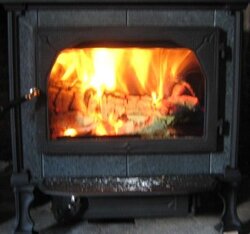This morning it was nice and cold up here in the Litchfield Hills and a good time to fill up my new Mansfield's wood box and get a real fire going. I'm about 2 hours into it and wondering whether the stove has an air leak, or I just need to get used to a bigger stove (my other stove is a Phoenix). I'm hoping one of you more experienced burners can sort this out.
I got a good fire going around 7 and filled the wood box with 9 or so splits of very dry wood. It didn't take long for the secondary burners to really get going and as soon as they did I shut the stove damper all the way down. For an hour or so there was a quiet whistling sound coming from the stove; the whistling has stopped but the stove isn't totally quiet - there is a faint noise which I can only guess is air moving. There is a slight breeze outside.
Now, at around 9:30, the stove temp is 350 degrees and there are still very active flames. The splits have burned to about half their previous size. Under the same conditions the Phoenix (which was installed in the same fireplace, with the same chimney) wouldn't have any active flames, just glowing coals. I've attached a picture which may or not be helpful.
So - what do you all think? Normal for a Mansfield? Normal for a new Mansfield? Or completely out of the ordinary?
I got a good fire going around 7 and filled the wood box with 9 or so splits of very dry wood. It didn't take long for the secondary burners to really get going and as soon as they did I shut the stove damper all the way down. For an hour or so there was a quiet whistling sound coming from the stove; the whistling has stopped but the stove isn't totally quiet - there is a faint noise which I can only guess is air moving. There is a slight breeze outside.
Now, at around 9:30, the stove temp is 350 degrees and there are still very active flames. The splits have burned to about half their previous size. Under the same conditions the Phoenix (which was installed in the same fireplace, with the same chimney) wouldn't have any active flames, just glowing coals. I've attached a picture which may or not be helpful.
So - what do you all think? Normal for a Mansfield? Normal for a new Mansfield? Or completely out of the ordinary?


